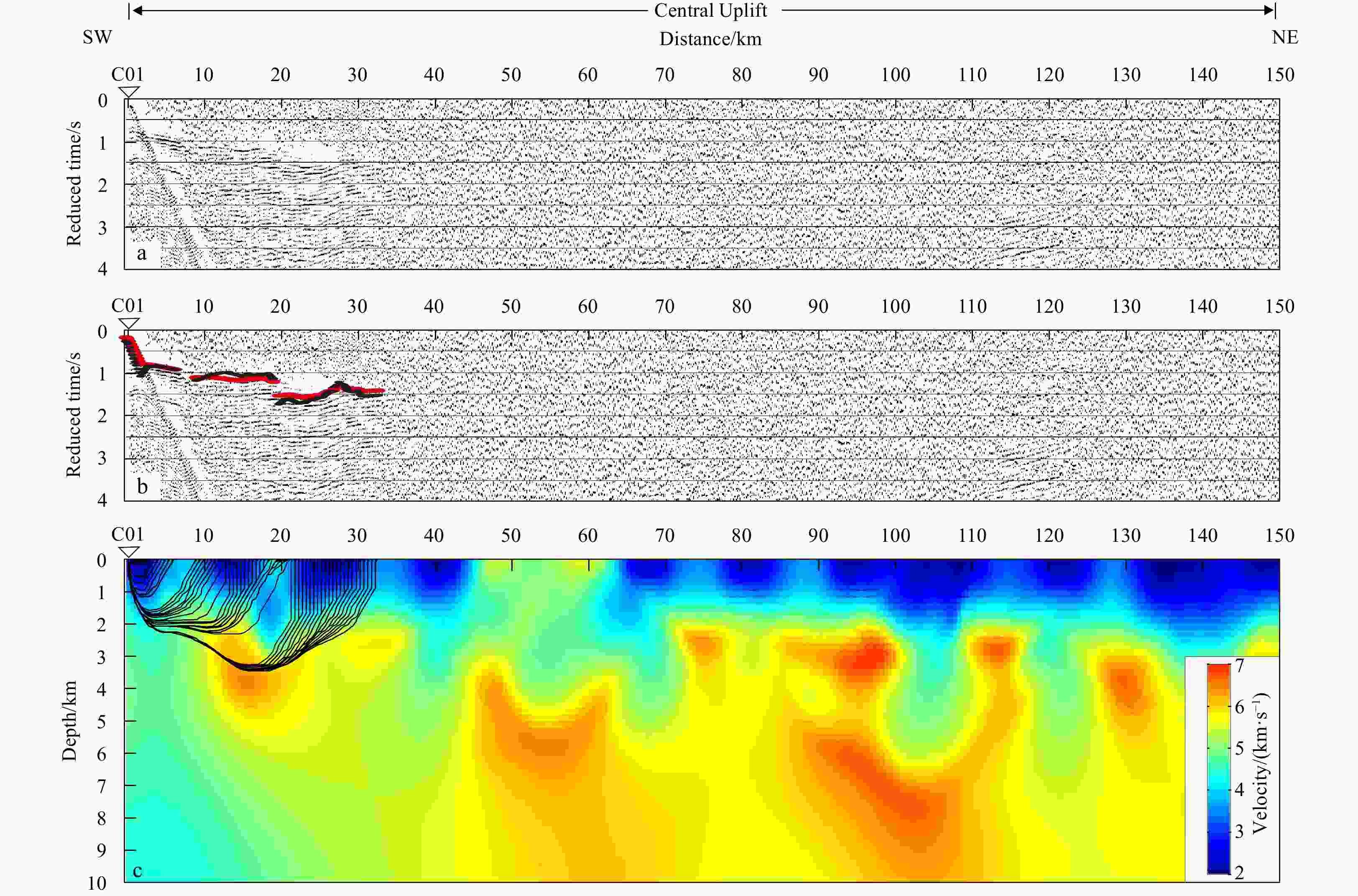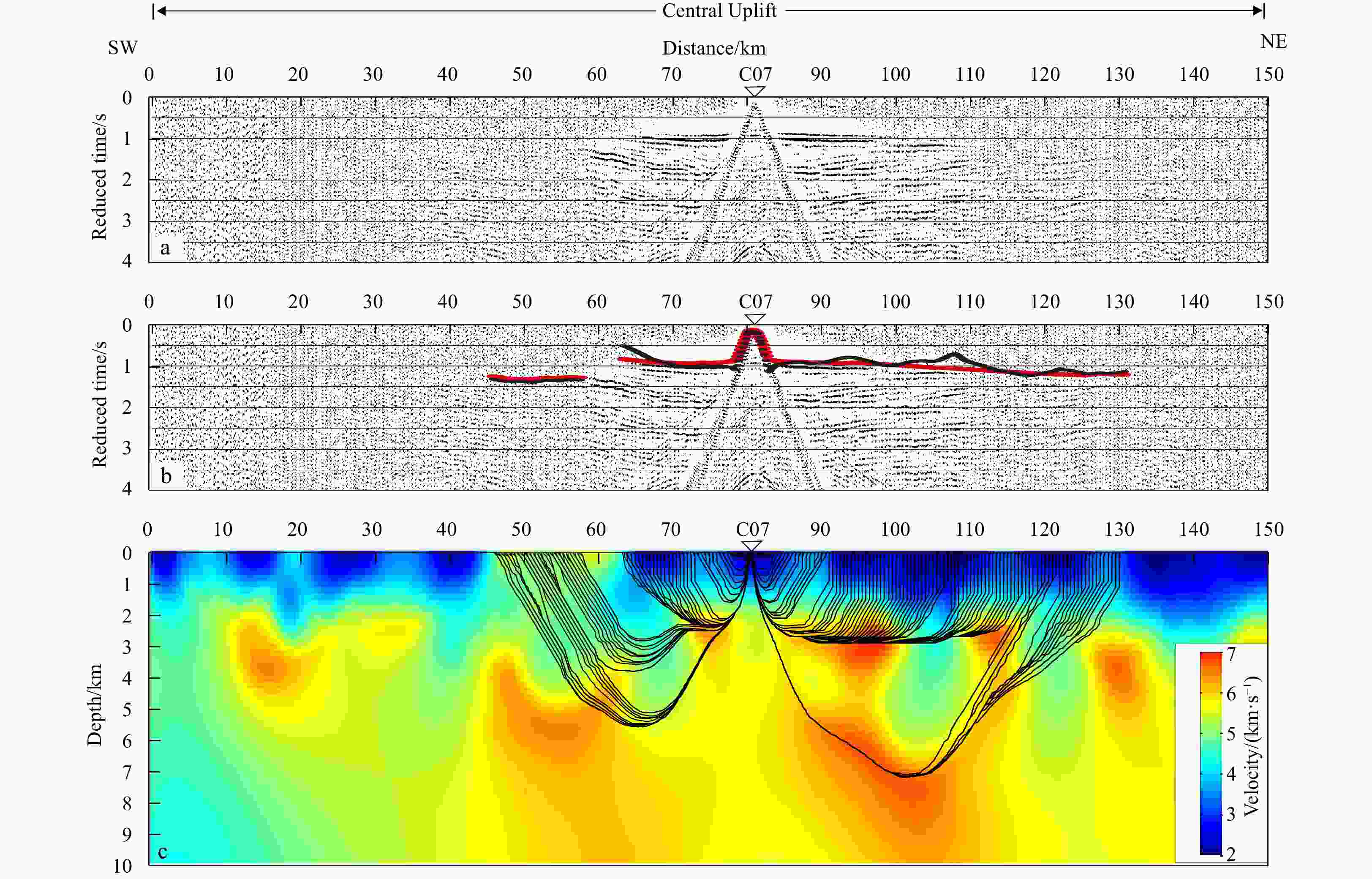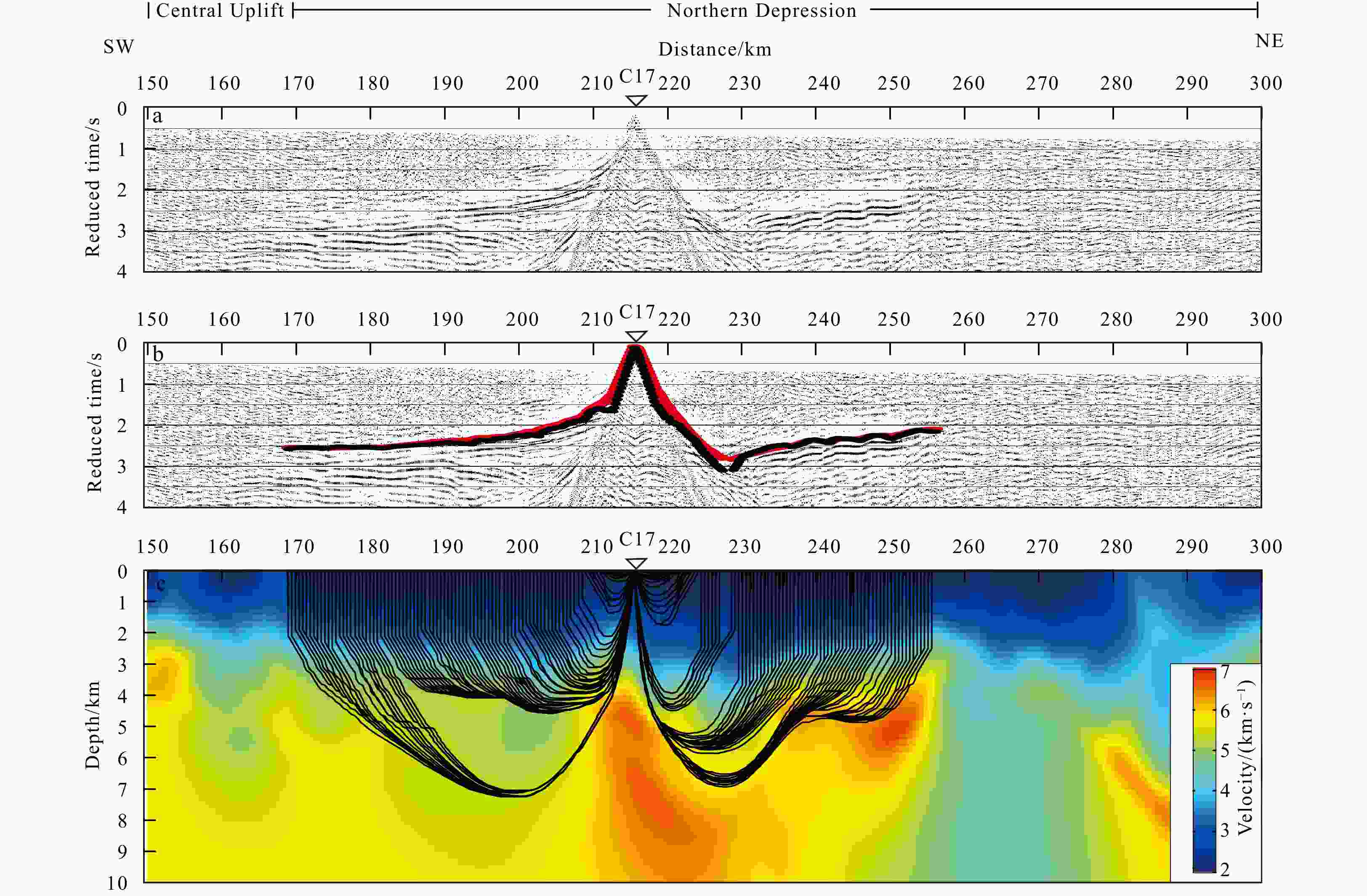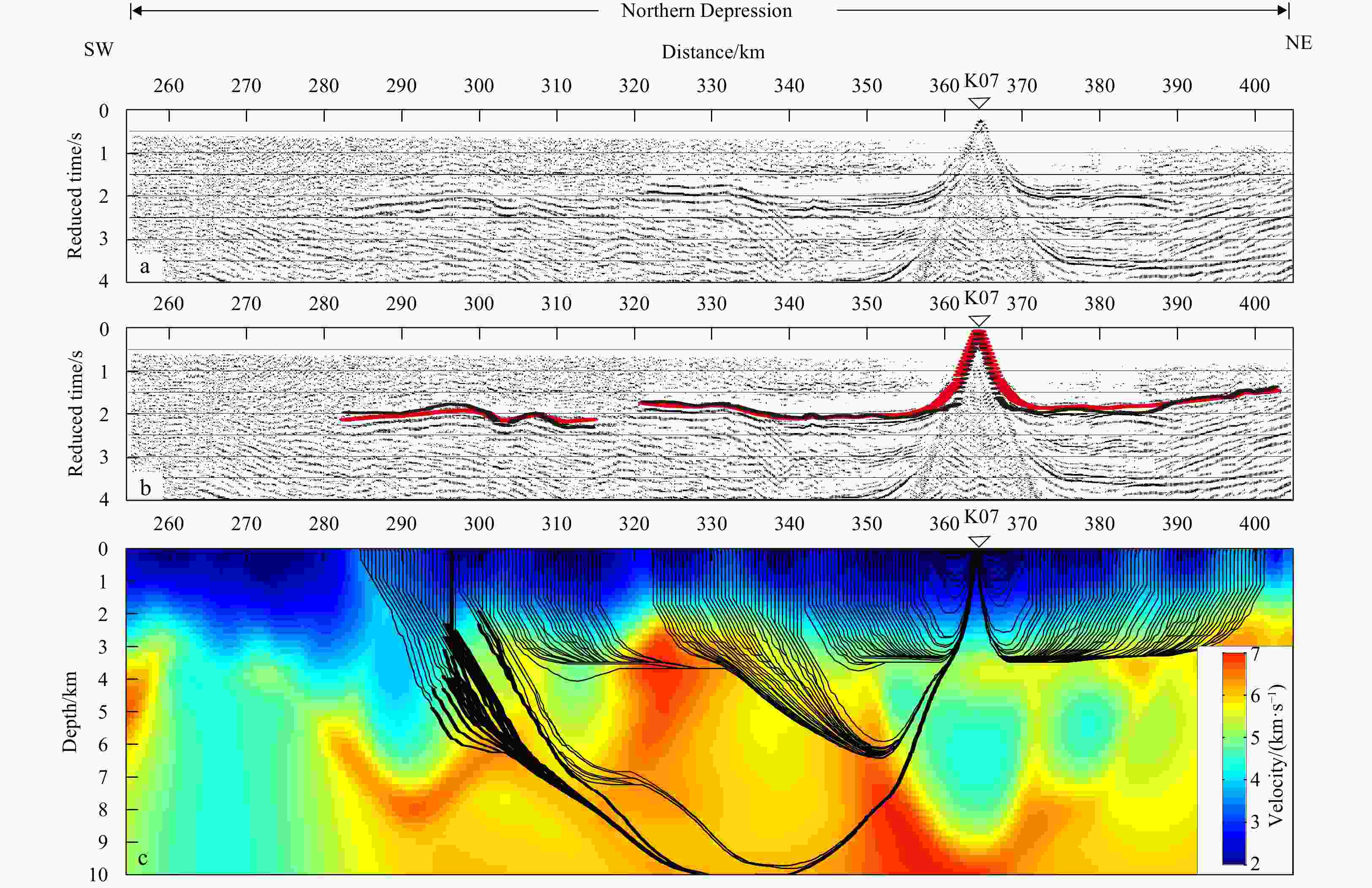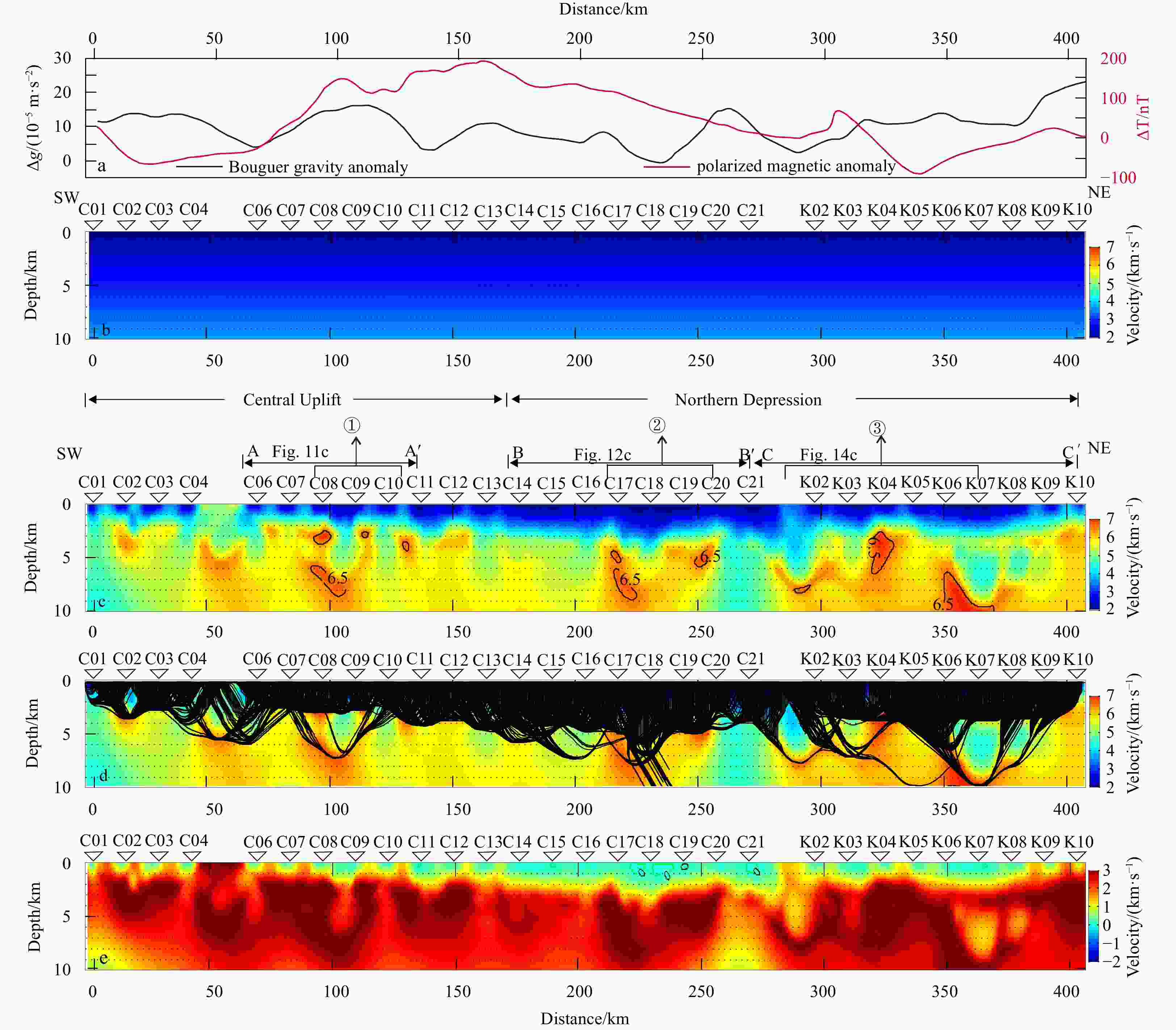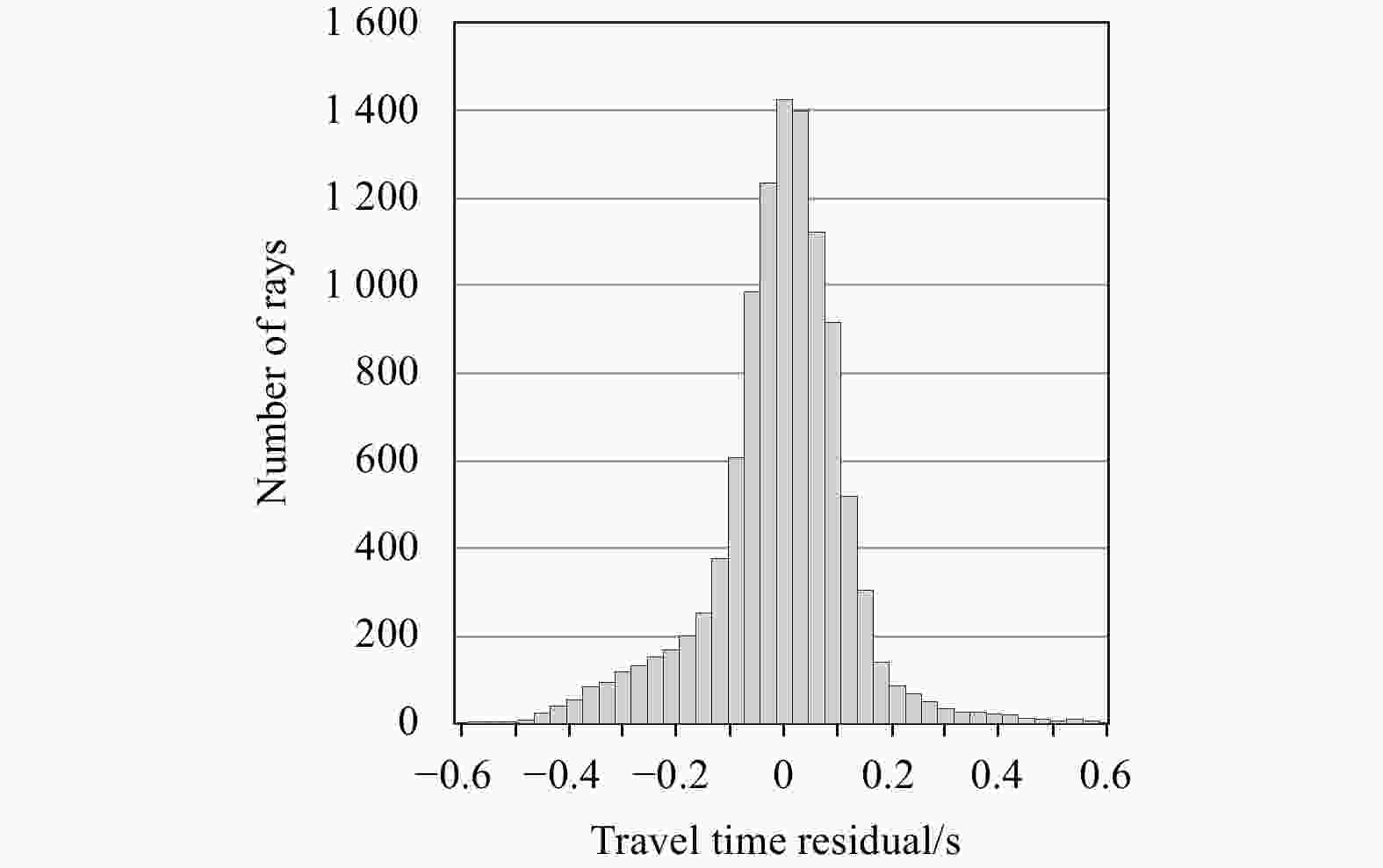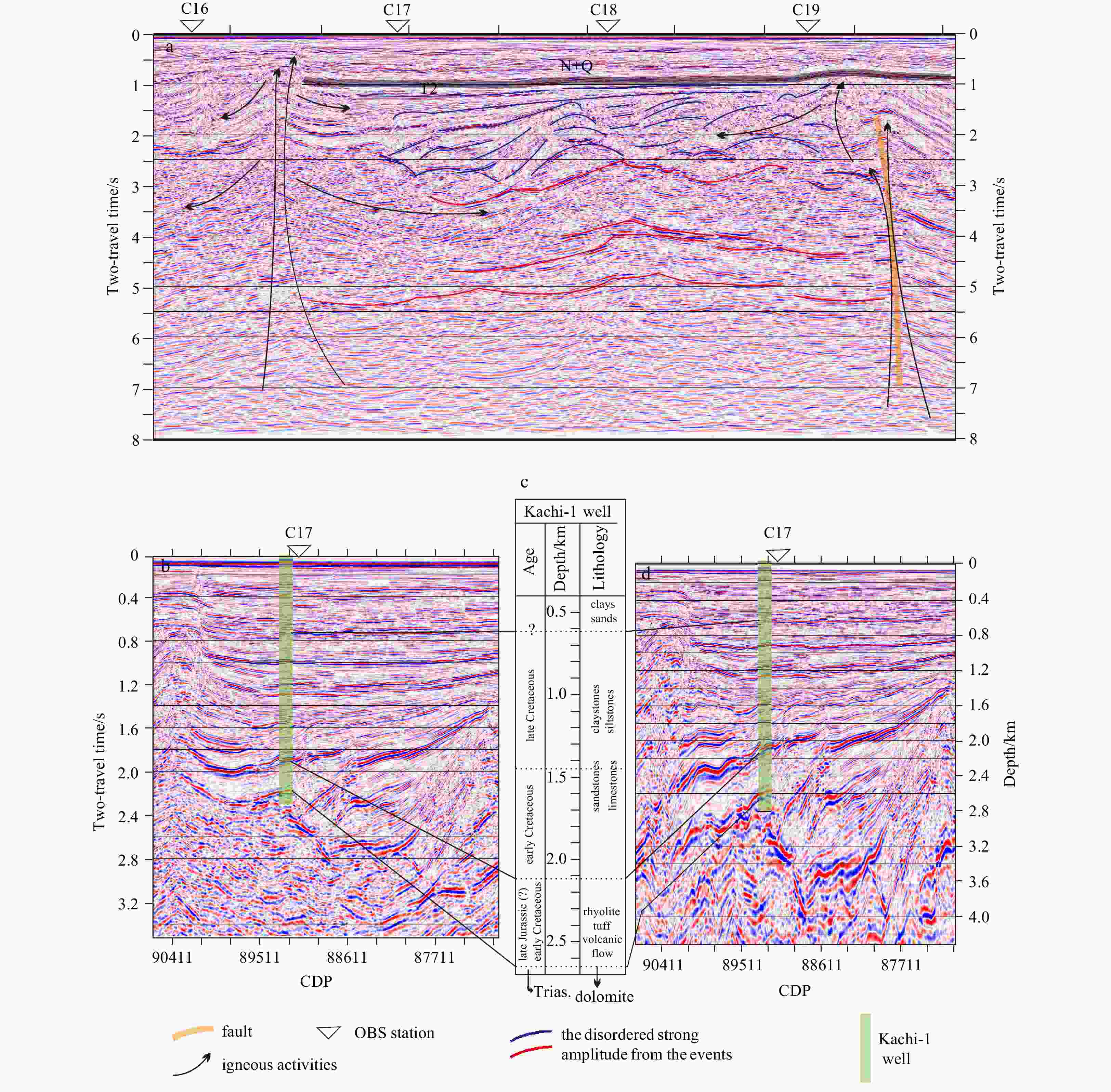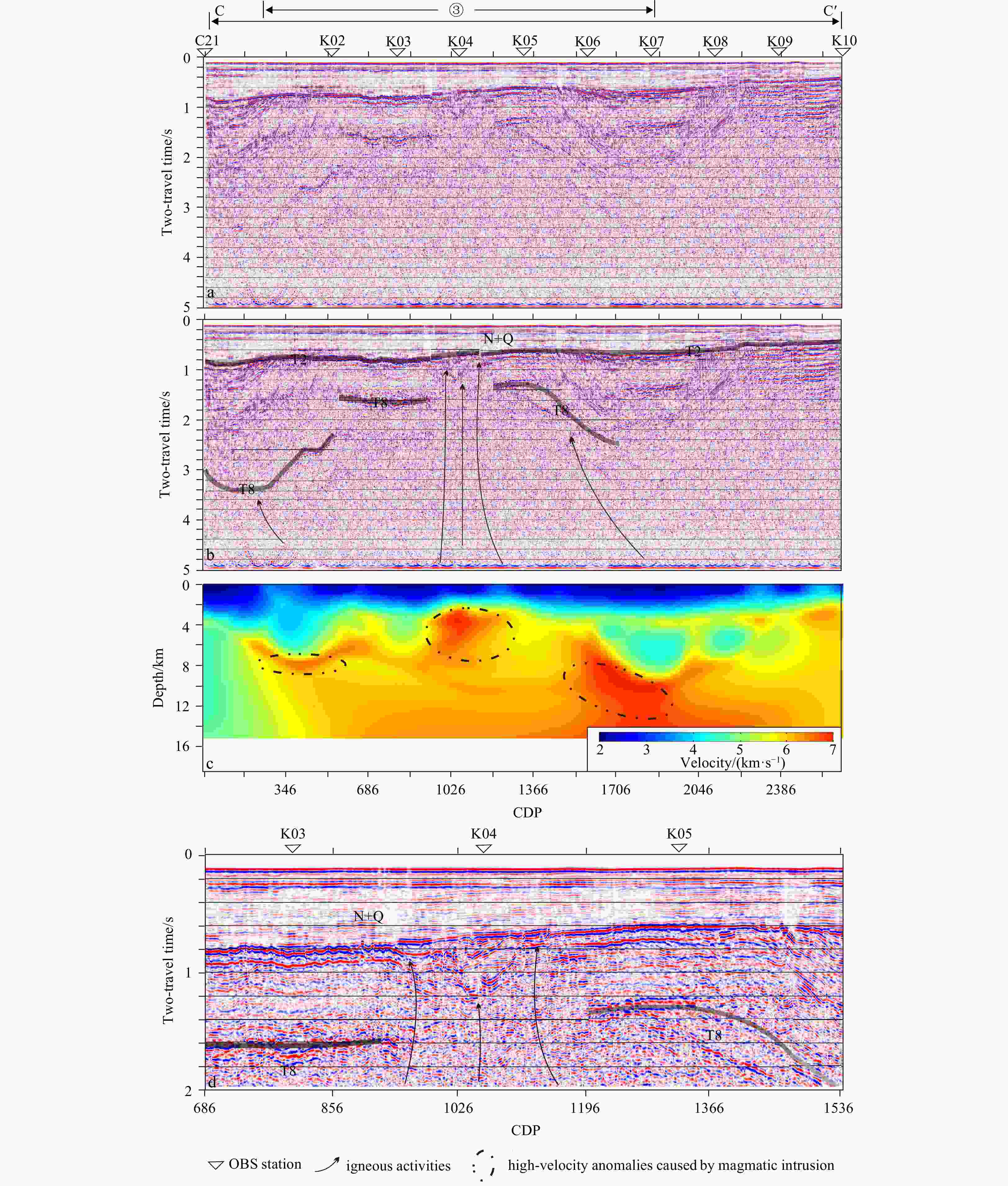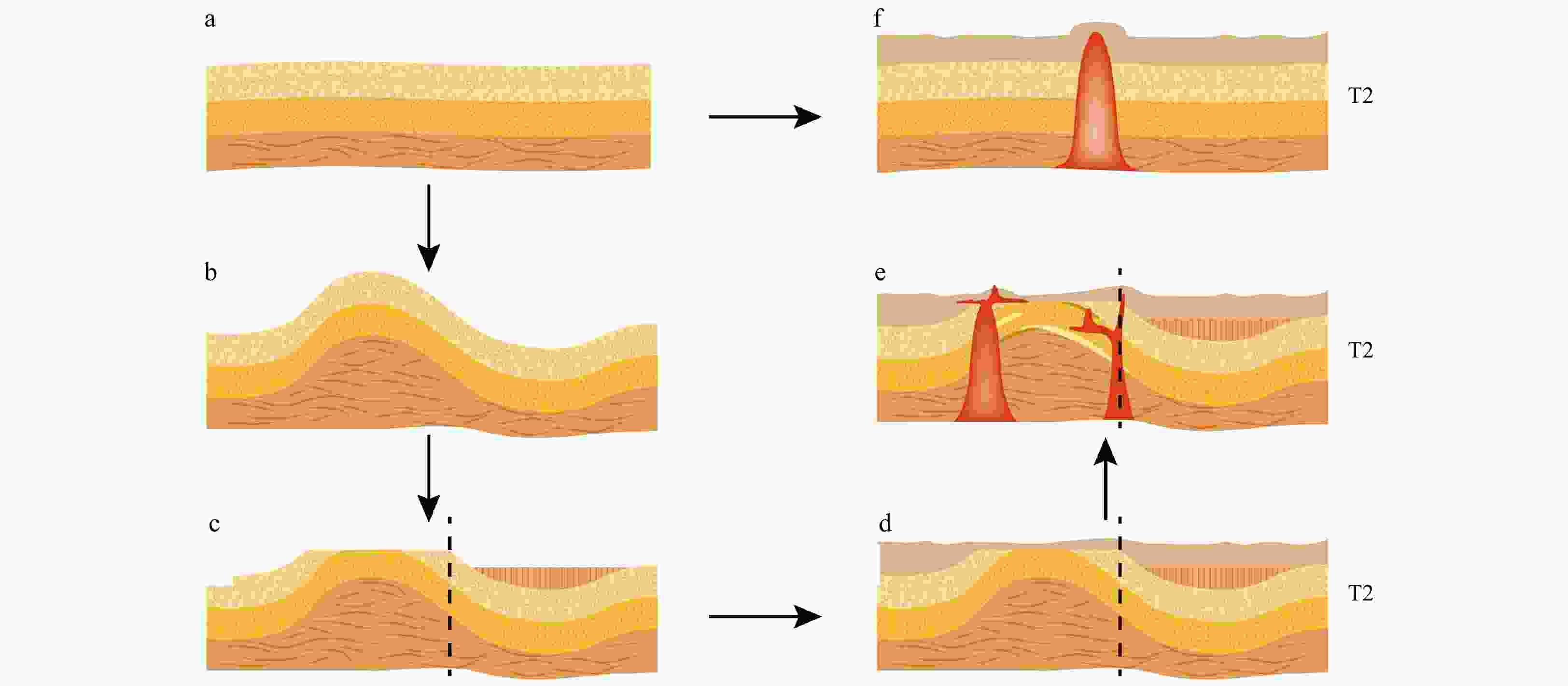Velocity structure in the South Yellow Sea basin based on first-arrival tomography of wide-angle seismic data and its geological implications
-
Abstract: The South Yellow Sea basin is filled with Mesozoic–Cenozoic continental sediments overlying pre-Palaeozoic and Mesozoic–Palaeozoic marine sediments. Conventional multi-channel seismic data cannot describe the velocity structure of the marine residual basin in detail, leading to the lack of a deeper understanding of the distribution and lithology owing to strong energy shielding on the top interface of marine sediments. In this study, we present seismic tomography data from ocean bottom seismographs that describe the NEE-trending velocity distributions of the basin. The results indicate that strong velocity variations occur at shallow crustal levels. Horizontal velocity bodies show good correlation with surface geological features, and multi-layer features exist in the vertical velocity framework (depth: 0–10 km). The analyses of the velocity model, gravity data, magnetic data, multi-channel seismic profiles, and drilling data showed that high-velocity anomalies (>6.5 km/s) of small (thickness: 1–2 km) and large (thickness: >5 km) scales were caused by igneous complexes in the multi-layer structure, which were active during the Palaeogene. Possible locations of good Mesozoic and Palaeozoic marine strata are limited to the Central Uplift and the western part of the Northern Depression along the wide-angle ocean bottom seismograph array. Following the Indosinian movement, a strong compression existed in the Northern Depression during the extensional phase that caused the formation of folds in the middle of the survey line. This study is useful for reconstructing the regional tectonic evolution and delineating the distribution of the marine residual basin in the South Yellow Sea basin.
-
Figure 1. An overview of the study area and data. a. Location of the South Yellow Sea and the survey lines; b. layout of the effective ocean bottom seismograph (OBS) stations and wells in the tectonic units. Well locations are from Shinn et al. (2010) and Wu et al. (2019); inferred faults are from Hao et al. (2002); QU, Qianliyan Uplift; ND, Northern Depression; CU, Central Uplift; SD, Southern Depression; WU, Wunansha Uplift; NCB, North China Block; YB, Yangtze Block.
Figure 7. Picking first-arrival time (color lines) on the OBS gathers and theoretical calculation travel time (black lines) based on the final velocity model (Fig. 8c). Triangles, OBS stations of OBS2016.
Figure 8. Magnetic and gravity anomaly and tomographic velocity model beneath OBS2016. a. Magnetic and gravity anomaly (Zhang et al., 2022); b. initial velocity model; c. inverted seismic velocity with contours showing the velocity values (6.5 km/s, black lines); d. ray-paths (black lines) in the inverted velocity; e. differential velocity calculated by the inverted velocity from the initial velocity model with contours showing the velocity values (0 km/s, green lines). Triangles, OBS stations of OBS2016.
Figure 11. Joint interpretation of the velocity model and multi-channel seismic reflection. a. AA' multi-channel time seismic-reflection profile across the OBS2016; b. AA' multi-channel time seismic-reflection profile with geological interpretation; c. inversion velocity model; d. overlapped profiles of seismic velocity beneath parts of the OBS2016 and depth seismic-reflection profile. Q: Quaternary; N: Neogene; the gray transparent lines T2 and T8 is the bottom interface of the Neogene and continental basin, respectively; CDP: common depth point.
Figure 12. Joint interpretation of the velocity model and multi-channel seismic reflection. a. BB' multi-channel time seismic-reflection profile alongside the OBS2016; b. BB' multi-channel time seismic-reflection profile with geological interpretation; c. inversion velocity model; d. overlapped profiles of seismic velocity beneath parts of the OBS2016 and depth seismic-reflection profile; e. faults in part of BB' multi-channel time seismic-reflection profile. Q: Quaternary; N: Neogene; the gray transparent line T2 and T8 is the bottom interface of the Neogene and continental basin, respectively; CDP: common depth point.
Figure 13. Joint interpretation of the well and the multi-channel seismic reflection data. a. Disordered events in BB' multi-channel time seismic-reflection profile; b. time seismic-reflection profile from the BB'; c. Kachi-1 well information; d. depth seismic-reflection profile from the BB'. Q: Quaternary; N: Neogene; the gray transparent line T2 in a is the bottom interface of the Neogene; Trias.: Triassic; CDP: common depth point.
Figure 14. Joint interpretation of the velocity model and multi-channel seismic reflection. a. CC' multi-channel seismic reflection profile alongside the OBS2016; b. CC' multi-channel seismic reflection profile with geological interpretation; c. the local of the inversion velocity model; d. the local of the multi-channel seismic reflection profile (CC'). Q: Quaternary; N: Neogene; the gray transparent line T2 and T8 in b and d is the bottom interface of the Neogene and continental basin, respectively; CDP: common depth point.
Figure 15. Simplified graph of igneous activities and related geological processes in the Northern Depression of the South Yellow Sea basin. a. Pre-existing strata structure; b. forming folds in the strata; c. Strata denudation; d. restoring to accept sedimentation; e. igneous activities to the west; f. igneous activities model to the east. Red trees are the igneous activities; the black dashed lines indicate the fault.
Table 1. Strata velocity parameters calculated by vertical seismic profile data (after Wu et al. (2019))
Depth/m (from the seafloor) System Formation Vp/(m∙s−1) (max−min/average) 629 Cenozoic N+Q 1 600–2 332/1 803 863 Triassic T1q 4 341–6 157/5 387 915 Upper Paleozoic P3d 4 770–5 543/4 889 1 636 P3l 3 605–4 815/4 212 1 649 P2g 4 108–4 239/4 174 1 735 P2q 4 108–5 038/4 308 1 818 C3c 5 678–6 475/5 837 1 960 C2h 5 170–6 676/5 715 2 020 C1g 4 411–5 262/4 636 2 350 D3w 4 542–5 903/4 812 2 843.4 Lower Paleozoic S1 4 586–5 820/4 922 Note: Vp represents P-wave velocity. -
Aki K, Lee W H K. 1976. Determination of three-dimensional velocity anomalies under a seismic array using first P arrival times from local earthquakes: 1. A homogeneous initial model. Journal of Geophysical Research, 81(23): 4381–4399. doi: 10.1029/JB081i023p04381 Cai Laixing, Xiao Guolin, Guo Xingwei, et al. 2019. Assessment of Mesozoic and Upper Paleozoic source rocks in the South Yellow Sea Basin based on the continuous borehole CSDP-2. Marine and Petroleum Geology, 101: 30–42. doi: 10.1016/j.marpetgeo.2018.11.028 Gao Xiaohui, Zhang Xunhua, Guo Xingwei, et al. 2020. Provenance and tectonic implications of Paleozoic strata in the South Yellow Sea Basin, China-revealed from the borehole CSDP-2. Journal of Ocean University of China, 19(3): 536–550. doi: 10.1007/s11802-020-4088-y Hao Tianyao, Huang Song, Xu Ya, et al. 2010. Geophysical understandings on deep structure in Yellow Sea. Chinese Journal of Geophysics (in Chinese), 53(6): 1315–1326 Hao Tianyao, Suh M, Wang Qianshen, et al. 2002. A study on the extension of fault zones in Yellow Sea and its adjacent areas based on gravity data. Chinese Journal of Geophysics (in Chinese), 45(3): 385–397 He Enyuan, Zhao Minghui, Qiu Xuelin, et al. 2016. Crustal structure across the post-spreading magmatic ridge of the East Sub-basin in the South China Sea: tectonic significance. Journal of Asian Earth Sciences, 121: 139–152. doi: 10.1016/j.jseaes.2016.03.003 Hong T K, Choi H. 2012. Seismological constraints on the collision belt between the North and South China blocks in the Yellow Sea. Tectonophysics, 570–571: 102–113 Hou Hesheng, Gao Rui, Lu Zhanwu, et al. 2009. First arrival seismic tomographic imaging test of the near-surface velocity structure of central uplift in the Qiangtang Basin, Qinghai-Tibet Plateau. Geological Bulletin of China (in Chinese), 28(6): 738–745 Huang Song, Hao Tianyao, Xu Ya, et al. 2010. Study on macro distribution of residual basin of South Yellow Sea. Chinese Journal of Geophysics (in Chinese), 53(6): 1344–1353 Kim H J, Kim C H, Hao Tianyao, et al. 2019. Crustal structure of the Gunsan Basin in the SE Yellow Sea from ocean bottom seismometer (OBS) data and its linkage to the South China Block. Journal of Asian Earth Sciences, 180: 103881. doi: 10.1016/j.jseaes.2019.103881 Lei Baohua, Chen Jianwen, Liang Jie, et al. 2018a. Tectonic deformation and evolution of the South Yellow Sea basin since Indosinian movement. Marine Geology & Quaternary Geology (in Chinese), 38(3): 45–54 Lei Baohua, Chen Jianwen, Wu Zhiqiang, et al. 2018b. Density and velocity analysis and seismic reflection model construction of marine Mesozoic-Paleozoic in the North Jiangsu-to-South Yellow Sea Basin. Oil Geophysical Prospecting (in Chinese), 53(3): 558–576 Li Sanzhong, Jahn B M, Zhao Shujuan, et al. 2017. Triassic southeastward subduction of North China Block to South China Block: insights from new geological, geophysical and geochemical data. Earth-Science Reviews, 166: 270–285. doi: 10.1016/j.earscirev.2017.01.009 Li Nan, Li Weiran, Long Haiyan, 2016. Tectonic evolution of the north depression of the South Yellow Sea basin since late Cretaceous. Journal of Ocean University of China, 15(6): 967–976 Liu Kai, Liu Huaishan, Wu Zhiqiang, et al. 2016. Seismic acquisition parameters analysis for deep weak reflectors in the South Yellow Sea. Journal of Ocean University of China, 15(5): 758–766. doi: 10.1007/s11802-016-2978-9 Pang Yumao, Guo Xingwei, Han Zuozhen, et al. 2019. Mesozoic–Cenozoic denudation and thermal history in the Central Uplift of the South Yellow Sea basin and the implications for hydrocarbon systems: constraints from the CSDP-2 borehole. Marine and Petroleum Geology, 99: 355–369. doi: 10.1016/j.marpetgeo.2018.10.027 Qi Jianghao, Wu Zhiqiang, Guo Xingwei, et al. 2019. Application of large capacity air gun source in VSP data acquisition under marine high speed shielding layer in South Yellow Sea: illustrated by the example of well CSDP (Continental Shelf Drilling Program)-2. Progress in Geophysics (in Chinese), 34(4): 1661–1670 Shinn Y J. 2015. Geological structures and controls on half-graben inversion in the western Gunsan Basin, Yellow Sea. Marine and Petroleum Geology, 68: 480–491. doi: 10.1016/j.marpetgeo.2015.09.013 Shinn Y J, Chough S K, Hwang I G. 2010. Structural development and tectonic evolution of Gunsan Basin (Cretaceous-Tertiary) in the central Yellow Sea. Marine and Petroleum Geology, 27(2): 500–514. doi: 10.1016/j.marpetgeo.2009.11.001 Tao Kai, Grand S P, Niu Fenglin. 2018. Seismic structure of the upper mantle beneath eastern asia from full waveform seismic tomography. Geochemistry, Geophysics, Geosystems, 19(8): 2732–2763, Wang Wei, Chen Gao, Wang Jialin, et al. 1999. Analysis for regional structural characteristics of North Jiangsu-South Yellow Sea basin. Journal of Seismology (in Chinese), (1): 47–55 Wang Jian, Zhao Minghui, He Enyuan, et al. 2014. The selection of optimal inversion parameters for first-arrival seismic tomography: an application to 3D seismic data from the central sub-basin of the South China Sea. Journal of Tropical Oceanography (in Chinese), 33(5): 74–83 Weekly R T, Wilcock W S D, Toomey D R, et al. 2014. Upper crustal seismic structure of the Endeavour segment, Juan de Fuca Ridge from traveltime tomography: implications for oceanic crustal accretion. Geochemistry, Geophysics, Geosystems, 15(4): 1296–1315 Wu Zhiqiang. 2009. The seismic techniques for exploring marine facies stratigraphic hydrocarbon entrapped in the Middle Uplift of the South Yellow Sea (in Chinese)[dissertation]. Qingdao: Ocean University of China Wu Zhiqiang, Liu Lihua, Xiao Guolin, et al. 2015. Progress and enlightenment of integrated geophysics exploration of marine residual basin in the South Yellow Sea. Progress in Geophysics (in Chinese), 30(6): 2945–2954 Wu Zhiqiang, Qi Jianghao, Zhang Xunhua, et al. 2019. Vertical seismic profiling survey on the Well CSDP-2 of the “continental shelf drilling program”. Chinese Journal of Geophysics (in Chinese), 62(9): 3492–3508 Yang Jinyu. 2009. Research on the tectonic relation between the South Yellow Sea basin and its adjacent area and distribution characteristic and tectonic evolution of the Mesozoic-Paleozoic marine strata (in Chinese)[dissertation]. Hangzhou: Zhejiang University Yang Yanqiu, Li Gang, Yi Chunyan. 2015. Characteristics of seismic reflection and geological ages of seismic sequences for marine strata in the South Yellow Sea basin. Journal of Northeast Petroleum University (in Chinese), 39(3): 50–59 Yao Yongjian, Feng Zhiqiang, Hao Tianyao, et al. 2008. A new understanding of the structural layers in the South Yellow Sea Basin and their hydrocarbon-bearing characteristics. Earth Science Frontiers, 15(6): 232–240 Yi S, Yi S, Batten D J, et al. 2003. Cretaceous and Cenozoic non-marine deposits of the northern South Yellow Sea Basin, offshore western Korea: palynostratigraphy and palaeoenvironments. Palaeogeography, Palaeoclimatology, Palaeoecology, 191(1): 15–44 Yuan Yong, Chen Jianwen, Zhang Yinguo, et al. 2018. Sedimentary system characteristics and depositional filling model of Upper Permian–Lower Triassic in South Yellow Sea Basin. Journal of Central South University, 25(12): 2910–2928. doi: 10.1007/s11771-018-3962-x Zelt C A, Barton P J. 1998. Three-dimensional seismic refraction tomography: a comparison of two methods applied to data from the Faeroe Basin. Journal of Geophysical Research: Solid Earth, 103(B4): 7187–7210. doi: 10.1029/97JB03536 Zhang Haiqi, Chen Jianwen, Li Gang, et al. 2009. Discovery from seismic survey in Laoshan Uplift of the South Yellow Sea and the significance. Marine Geology & Quaternary Geology (in Chinese), 29(3): 107–113 Zhang Xunhua, Wu Zhiqiang, Liu Lihua, et al. 2022. Submarine Seismic Exploration in the Eastern China Sea (in Chinese). Beijing: Science Press Zhang Minghua, Xu Deshu, Chen Jianwen. 2007. Geological structure of the Yellow Sea Area from regional gravity and magnetic interpretation. Applied Geophysics, 4(2): 75–83. doi: 10.1007/s11770-007-0011-1 Zhang Xunhua, Yang Jinyu, Li Gang, et al. 2014. Basement structure and distribution of Mesozoic-Paleozoic marine strata in the South Yellow Sea basin. Chinese Journal of Geophysics (in Chinese), 57(12): 4041–4051 Zhang Xunhua, Zhang Zhixun, Lan Xianhong, et al. 2013. Regional Geology in South Yellow Sea (in Chinese). Beijing: China Ocean Press Zhang Xiaohua, Zhang Xunhua, Wu Zhiqiang, et al. 2018. New understanding of Mesozoic-Paleozoic strata in the Central Uplift of the South Yellow Sea basin from the drilling of well CSDP-02 of the “Continental Shelf Drilling Program”. Chinese Journal of Geophysics (in Chinese), 61(6): 2369–2379 Zhao Minghui, He Enyuan, Sibuet J C, et al. 2018. Postseafloor spreading volcanism in the central east South China Sea and its formation through an extremely thin oceanic crust. Geochemistry, Geophysics, Geosystems, 19(3): 621-641 Zhao Weina, Wang Huigang, Shi Hongcai, et al. 2019a. Crustal structure from onshore-offshore wide-angle seismic data: application to northern Sulu Orogen and its adjacent area. Tectonophysics, 770: 228220. doi: 10.1016/j.tecto.2019.228220 Zhao Weina, Zhang Xunhua, Wang Huigang, et al. 2020. Characteristics and noise combination suppression of wide-angle Ocean Bottom Seismography (OBS) data in shallow water: a case study of profile OBS2016 in the South Yellow Sea. Chinese Journal of Geophysics (in Chinese), 63(6): 2415–2433 Zhao Weina, Zhang Xunhua, Zou Zhihui, et al. 2019b. Velocity structure of sedimentary formation in the South Yellow Sea Basin based on OBS data. Chinese Journal of Geophysics (in Chinese), 62(1): 183–196 Zou Zhihui, Liu Kai, Zhao Weina, et al. 2016. Upper crustal structure beneath the northern South Yellow Sea revealed by wide-angle seismic tomography and joint interpretation of geophysical data. Geological Journal, 51(S1): 108–122. doi: 10.1002/gj.2847 -




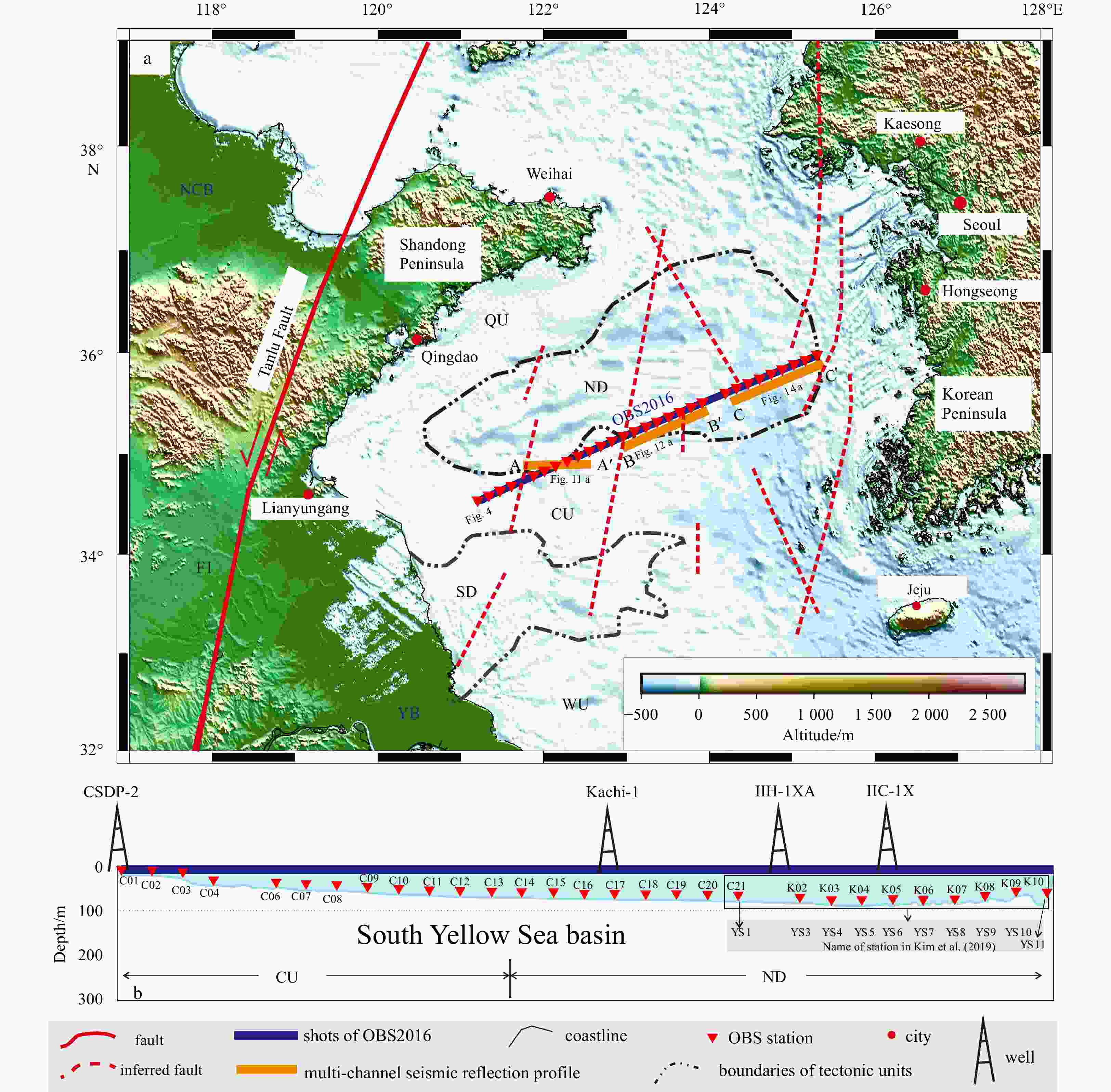
 下载:
下载:
